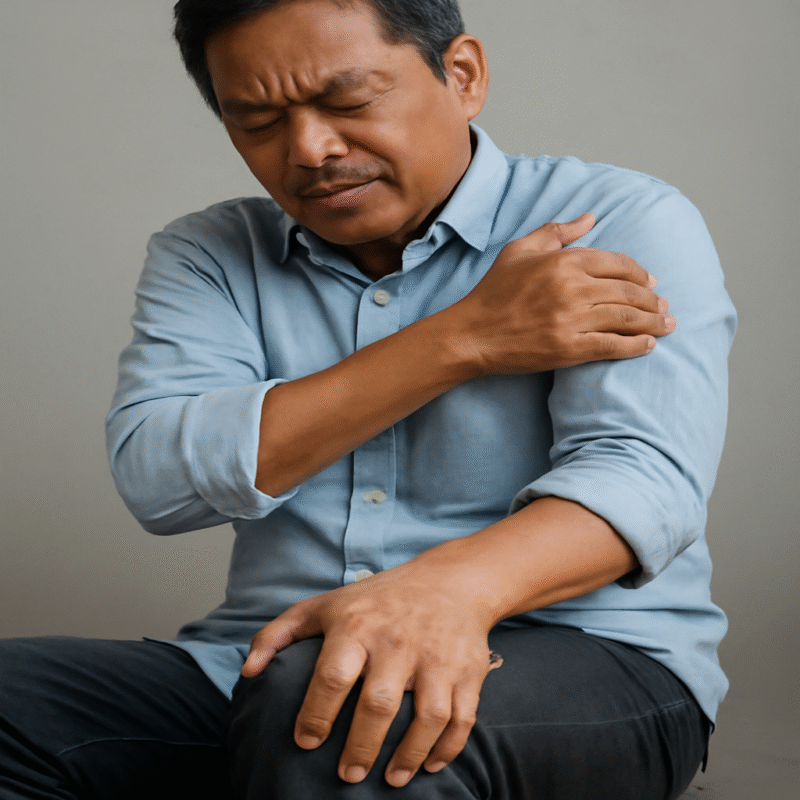Joint Problems
Joint problems are common and can arise due to various factors like aging, injury, overuse, or genetic conditions. These issues often affect mobility, flexibility, and can lead to chronic pain or discomfort.

Joint problems are common and can arise due to various factors like aging, injury, overuse, or genetic conditions. These issues often affect mobility, flexibility, and can lead to chronic pain or discomfort.

Below is a detailed explanation of common joint problems and their management:
What it is: Arthritis refers to the inflammation of one or more joints, causing pain, stiffness, and swelling. The most common types of arthritis are Osteoarthritis (OA), which is due to the wear and tear of cartilage, and Rheumatoid Arthritis (RA), which is an autoimmune condition where the body attacks the joints.
Symptoms: Joint pain, swelling, reduced range of motion, and stiffness, particularly after periods of rest.
Treatment: While arthritis cannot be cured, treatments can help manage symptoms. These include physical therapy, anti-inflammatory medications, joint protection techniques, weight management, and in severe cases, joint replacement surgery.
What it is: Hip pain can result from a variety of issues such as arthritis, tendonitis, or muscle strain. Conditions like bursitis, labral tears, or tendinopathy can also contribute to hip pain.
Symptoms: Pain in the front or side of the hip, groin pain, difficulty walking, and stiffness.
Treatment: Treatment can include rest, ice or heat therapy, anti-inflammatory medications, stretching, strengthening exercises, and, in severe cases, hip replacement surgery.
What it is: Shoulder impingement occurs when the tendons of the rotator cuff muscles are irritated or compressed, often due to repetitive overhead movements. Frozen shoulder (adhesive capsulitis) occurs when the shoulder capsule becomes stiff, limiting the range of motion.
Symptoms: Pain and weakness in the shoulder, especially with overhead movements. Limited range of motion and stiffness in frozen shoulder.
Treatment: Rest, physical therapy, anti-inflammatory medications, and corticosteroid injections. In severe cases, surgery may be necessary.
What it is: Following joint surgery (e.g., joint replacement, ligament repair, etc.), rehabilitation is essential for restoring movement, strength, and function. The goal is to regain full range of motion and improve strength to return to normal activities.
Symptoms: Post-surgery swelling, discomfort, and limited mobility.
Treatment: Physical therapy is often a key component, involving exercises to improve strength, flexibility, and mobility. Additional treatments may include pain management, assistive devices, and gradual weight-bearing activities.
What it is: After hip or knee replacement surgery, rehabilitation helps patients regain mobility and strength in the new joint. It focuses on reducing pain, improving range of motion, and rebuilding muscle strength around the joint.
Symptoms: Swelling, pain, and stiffness after surgery.
Treatment: Rehab usually starts with gentle movements and stretches to improve flexibility, progressing to strengthening exercises. Gait training and balance exercises also form a significant part of post-surgical rehabilitation.
What it is: Knee arthroscopy is a minimally invasive surgery used to diagnose and treat joint issues like torn cartilage or ligament damage. After the procedure, rehab helps to reduce pain, swelling, and restore knee function.
Symptoms: Swelling, tenderness, and limited movement in the knee.
Treatment: Initial rest and ice therapy are followed by physical therapy that focuses on regaining knee strength, stability, and flexibility. Exercises might include quadriceps strengthening, hamstring stretches, and balance exercises.
What it is: Hypermobility refers to joints that can move beyond the normal range of motion. While this condition isn’t necessarily problematic for everyone, it can lead to joint pain, instability, and increased risk of injury for some individuals.
Symptoms: Joint pain, frequent dislocations or subluxations (partial dislocations), and increased joint instability.
Treatment: Managing hypermobility often involves strengthening the muscles around hypermobile joints to provide better support. Physical therapy and exercises aimed at improving joint stability and preventing injuries are key.
•Arthritis
•Hip pain
•Shoulder impingement/frozen
•Rehabilitation after surgery
•Post knee and hip replacement rehab
•Post knee arthroscopy rehab
•Hypermobility
Physical Therapy: Strengthening and stabilizing exercises tailored to the specific joint problem can be crucial in improving mobility and reducing pain.
Medications: Anti-inflammatory medications (like ibuprofen), pain relievers, and in some cases, disease-modifying drugs (for conditions like arthritis) can help manage symptoms.
Surgical Interventions: In cases where non-surgical treatments don’t provide relief, surgical procedures such as joint replacements, arthroscopy, or ligament repair may be considered.
Assistive Devices: Braces, splints, and orthotics can help reduce pain and improve mobility.
Lifestyle Modifications: Maintaining a healthy weight, avoiding overuse of joints, and practicing proper body mechanics during daily activities are essential in preventing further damage.
Joint problems can significantly affect a person’s quality of life, but with proper treatment, rehabilitation, and self-care, many individuals can regain function and reduce pain. If you experience joint pain, it’s essential to consult a healthcare professional to determine the cause and receive personalized treatment plans.
book now